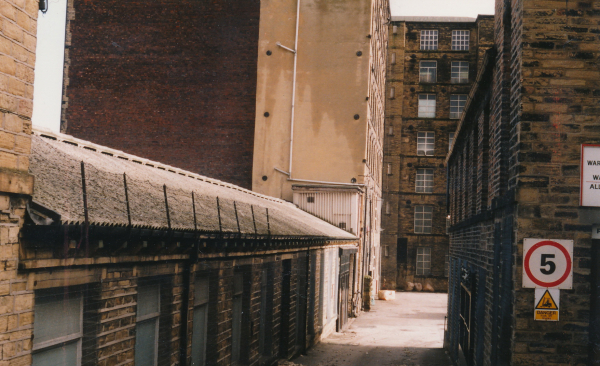In 1861, Jonathan and Henry Stott to help with their already expanding business in the Victoria Mills complex (this is now occupied by Sainsbury's Supermarket) moved into Mill Royd Mill. The mill was soon to be referred to by its workers as 'Stott's Mill'. The original mill had two major fires, the first in 1868 which caused £12,000 worth of damage, but the second in 1874 completely destroyed the mill. This saw a new replacement mill being built but even that was not without its problems. It transpired that the front part of the new mill was built on quicksand and caused the centre portion of the mill to have settlement in its foundations.This caused friction in the main shaft which cause yet another fire. Although the fire was extinguished it was apparent that the ground was unstable, and the decision was taken to demolish that end of the mill.
On our featured photograph the seven-storey mill section in the distance and to the left is what remains of the Mill Royd mill. The single storey building on the left is all that remained after the end of the mill was demolished and the high light and dark coloured wall is the end of the mill that was left after the demolition.

An aerial view of the Mill Royd Mill complex during the late 1970s early 1980s. All the property which is nearest the main Huddersfield Road was demolished. To the right of the canal are the mill buildings that were part of the Victoria Mills complex, they were also demolished to make way for the new Sainsbury's Supermarket in 2000. It is interesting to note that opposite the single storey buildings is Crowtrees Garage, that was to eventually close and was replaced with a fireplace business.
In later years the mill was occupied by Henry Cullingworth and often referred to as 'Cullingworth's Mill. It was also the home for many years of the Initial Towel Company. In 2003, the old mill was purchased by Richard Binks, the owner of Binks Vertical, a development company and converted it into apartments.

Today, all that remains of 'Stott's Mill is the seven-storey structure that once employed hundreds of local people. Who would have all walked down this narrow passage to go and clock -on for their daily work. In the nineteenth century this would have included young children who often had key jobs like piecing (Piecers had to lean over the spinning-machine to repair the broken threads). They also helped the blenders to mix the cotton from the bales. They were used to fetch and carry baskets of cotton or bobbins from room to room. Carrying pails of water from the well to the spinning rooms, to keep the floors damp to prevent the threads from breaking was no easy job for these youngsters.
Look over the wall in Huddersfield Road today at the same view the photographer had in 1995. You are faced with a large car park which is for the residents of what was 'Stott's Mill’ but known today as Mill Royd Island Apartments. Here we have a simple photograph taken twenty-two years ago, that is oozing with history and a story to tell about just a small but very important area just outside the town centre.

Here is the completed Mill Royd Island apartmernts with over 100 apartments. It is thanks to Richard Binks and his company for having the foresight to carry out this conversion. Sadly, Richard Binks passed away a few months ago. What a legacy he has left us with and one that Brighouse can appreciate for many years to come.





















